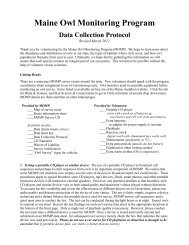Focus Species Forestry - Maine Audubon
Focus Species Forestry - Maine Audubon
Focus Species Forestry - Maine Audubon
You also want an ePaper? Increase the reach of your titles
YUMPU automatically turns print PDFs into web optimized ePapers that Google loves.
Appendix 4. Other Special-value Habitats<br />
<strong>Focus</strong> species management is designed as a tool to help guide management of the bulk of the landscape<br />
and a vast majority of species commonly encountered by forest managers. However, focus species<br />
management may not account for rare species with unique habitat requirements, rare forest types, species<br />
that are highly sensitive to timber harvesting, or other specialized habitats. Landowners should also<br />
integrate management of these important ecological features into the management plan for their property.<br />
Element Description Information Source/Management<br />
Rare, threatened,<br />
or endangered<br />
plants<br />
Plants listed under the federal Endangered<br />
<strong>Species</strong> Acts and other species listed S1,<br />
S2, or S3 by MNAP 1<br />
Threatened or<br />
endangered<br />
animals<br />
Rare or exemplary<br />
natural<br />
communities<br />
Animals listed under the federal and<br />
<strong>Maine</strong> endangered species acts<br />
Natural communities classified as S1, S2,<br />
or S3 or “exemplary” communities<br />
<strong>Maine</strong> Natural Areas Program<br />
Good: Protect known occurrences.<br />
Foresters should be able to identify rare<br />
forest communities.<br />
Better: Manage appropriately if<br />
MNAP data suggests possible<br />
occurrences.<br />
Best: Conduct on-site surveys<br />
Old growth forests Stands over 150-200 years old with light<br />
harvest history<br />
Protect existing stands and allow some<br />
additional old growth to develop.<br />
Significant<br />
wildlife habitat<br />
Threatened or endangered species habitat,<br />
high- and moderate-value deer wintering<br />
areas and travel corridors; high- and<br />
moderate-value waterfowl and wading<br />
bird habitat; Atlantic salmon spawning<br />
and nursery areas; and other non-forest<br />
areas listed by the Natural Resources<br />
Protection Act<br />
<strong>Maine</strong> Department of Inland Fisheries<br />
and Wildlife (MDIFW) or <strong>Maine</strong><br />
Natural Areas Program. Mapped<br />
Significant Wildlife Habitats are<br />
protected by law. Protection of<br />
unmapped habitats is voluntary unless<br />
within a wetland or other protected<br />
resource.<br />
Deer wintering<br />
areas<br />
Spruce, fir, cedar or hemlock stands with<br />
>50% crown closure and >30 ft. tall with<br />
historical deer “yarding”<br />
Review Beginning with Habitat map.<br />
Consult with regional MDIFW<br />
biologist.<br />
Heron Rookeries Look for concentrations of large stick MDIFW<br />
nests, usually in hardwoods (occasionally<br />
softwoods), near rivers, wetlands, or on<br />
islands.<br />
See Biodiversity in the Forests of <strong>Maine</strong>: Guidelines for Land Management (Elliott 1999) for more<br />
information on identifying and managing these special habitats.<br />
1<br />
<strong>Maine</strong> Natural Areas Program (MNAP) classifies rare plants and natural communities with the following<br />
system:<br />
S1: Critically imperiled in <strong>Maine</strong> because or rarity (5 or less occurrences) or because it is<br />
especially vulnerable to extirpation<br />
S2: Imperiled in <strong>Maine</strong> because of rarity (6-20 occurrences or few remaining acres) or because<br />
other factors make it vulnerable to further decline<br />
S3: Rare in <strong>Maine</strong> (on the order of 20-100 occurrences)<br />
S4: Apparently secure in <strong>Maine</strong><br />
S5: Demonstrably secure in <strong>Maine</strong><br />
<strong>Focus</strong> <strong>Species</strong> <strong>Forestry</strong> 79



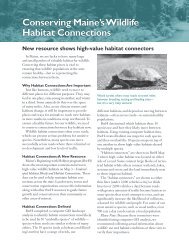
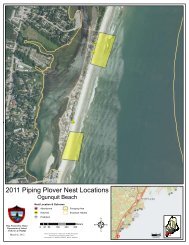
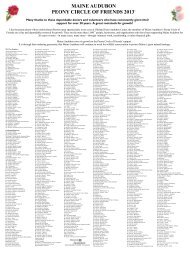
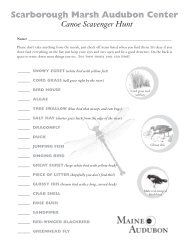

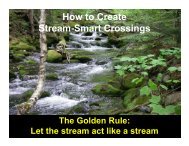
![2012 Loon Count Results [pdf] - Maine Audubon](https://img.yumpu.com/26228732/1/190x245/2012-loon-count-results-pdf-maine-audubon.jpg?quality=85)
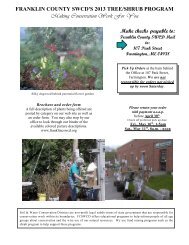
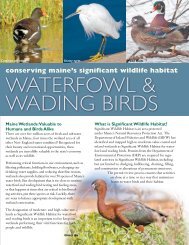
![Lake Fish of Maine (DIFW list) [pdf] - Maine Audubon](https://img.yumpu.com/23282964/1/190x245/lake-fish-of-maine-difw-list-pdf-maine-audubon.jpg?quality=85)
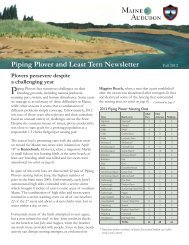

![The Maine Audubon Peony Circle of Friends 2012 [pdf]](https://img.yumpu.com/22707677/1/190x253/the-maine-audubon-peony-circle-of-friends-2012-pdf.jpg?quality=85)
